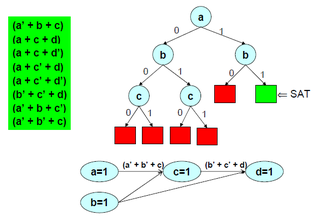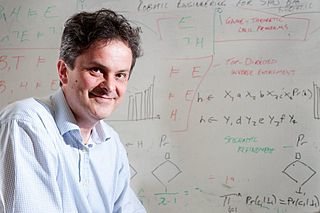Related Research Articles
Logic programming is a programming, database and knowledge-representation and reasoning paradigm which is based on formal logic. A program, database or knowledge base in a logic programming language is a set of sentences in logical form, expressing facts and rules about some problem domain. Major logic programming language families include Prolog, Answer Set Programming (ASP) and Datalog. In all of these languages, rules are written in the form of clauses:
Prolog is a logic programming language that has its origins in artificial intelligence and computational linguistics.
Inductive logic programming (ILP) is a subfield of symbolic artificial intelligence which uses logic programming as a uniform representation for examples, background knowledge and hypotheses. The term "inductive" here refers to philosophical rather than mathematical induction. Given an encoding of the known background knowledge and a set of examples represented as a logical database of facts, an ILP system will derive a hypothesised logic program which entails all the positive and none of the negative examples.
The inductive bias of a learning algorithm is the set of assumptions that the learner uses to predict outputs of given inputs that it has not encountered. Inductive bias is anything which makes the algorithm learn one pattern instead of another pattern.
Curry is a declarative programming language, an implementation of the functional logic programming paradigm, and based on the Haskell language. It merges elements of functional and logic programming, including constraint programming integration.
In artificial intelligence and operations research, constraint satisfaction is the process of finding a solution through a set of constraints that impose conditions that the variables must satisfy. A solution is therefore an assignment of values to the variables that satisfies all constraints—that is, a point in the feasible region.
Golem is an inductive logic programming algorithm developed by Stephen Muggleton and Cao Feng in 1990. It uses the technique of relative least general generalisation proposed by Gordon Plotkin, leading to a bottom-up search through the subsumption lattice. In 1992, shortly after its introduction, Golem was considered the only inductive logic programming system capable of scaling to tens of thousands of examples.
In computer science, an abstract semantic graph (ASG) or term graph is a form of abstract syntax in which an expression of a formal or programming language is represented by a graph whose vertices are the expression's subterms. An ASG is at a higher level of abstraction than an abstract syntax tree, which is used to express the syntactic structure of an expression or program.
The closed-world assumption (CWA), in a formal system of logic used for knowledge representation, is the presumption that a statement that is true is also known to be true. Therefore, conversely, what is not currently known to be true, is false. The same name also refers to a logical formalization of this assumption by Raymond Reiter. The opposite of the closed-world assumption is the open-world assumption (OWA), stating that lack of knowledge does not imply falsity. Decisions on CWA vs. OWA determine the understanding of the actual semantics of a conceptual expression with the same notations of concepts. A successful formalization of natural language semantics usually cannot avoid an explicit revelation of whether the implicit logical backgrounds are based on CWA or OWA.

In logic and computer science, the Davis–Putnam–Logemann–Loveland (DPLL) algorithm is a complete, backtracking-based search algorithm for deciding the satisfiability of propositional logic formulae in conjunctive normal form, i.e. for solving the CNF-SAT problem.

Machine Learning is a peer-reviewed scientific journal, published since 1986.

Version space learning is a logical approach to machine learning, specifically binary classification. Version space learning algorithms search a predefined space of hypotheses, viewed as a set of logical sentences. Formally, the hypothesis space is a disjunction

Stephen H. Muggleton FBCS, FIET, FAAAI, FECCAI, FSB, FREng is Professor of Machine Learning and Head of the Computational Bioinformatics Laboratory at Imperial College London.
Abductive logic programming (ALP) is a high-level knowledge-representation framework that can be used to solve problems declaratively, based on abductive reasoning. It extends normal logic programming by allowing some predicates to be incompletely defined, declared as abducible predicates. Problem solving is effected by deriving hypotheses on these abducible predicates as solutions of problems to be solved. These problems can be either observations that need to be explained or goals to be achieved. It can be used to solve problems in diagnosis, planning, natural language and machine learning. It has also been used to interpret negation as failure as a form of abductive reasoning.

Ross Donald King is a Professor of Machine Intelligence at Chalmers University of Technology.
Inductive programming (IP) is a special area of automatic programming, covering research from artificial intelligence and programming, which addresses learning of typically declarative and often recursive programs from incomplete specifications, such as input/output examples or constraints.

Ingo Althöfer is a German mathematician at the University of Jena, where he holds the chair of operations research.
Deepak Kapur is a Distinguished Professor in the Department of Computer Science at the University of New Mexico.
Theta-subsumption is a decidable relation between two first-order clauses that guarantees that one clause logically entails the other. It was first introduced by John Alan Robinson in 1965 and has become a fundamental notion in inductive logic programming. Deciding whether a given clause θ-subsumes another is an NP-complete problem.
Aleph is an inductive logic programming system introduced by Ashwin Srinivasan in 2001. As of 2022 it is still one of the most widely used inductive logic programming systems. It is based on the earlier system Progol.
References
- ↑ Muggleton, S. (1995). "Inverse entailment and progol". New Generation Computing. 13 (3–4): 245–286. CiteSeerX 10.1.1.31.1630 . doi:10.1007/BF03037227. S2CID 12643399.
- ↑ Muggleton, S. (1997). "Learning from positive data". Inductive Logic Programming. Lecture Notes in Computer Science. Vol. 1314. pp. 358–376. doi:10.1007/3-540-63494-0_65. ISBN 978-3-540-63494-2.
- ↑ Srinivasan, A.; Muggieton, S.H.; Sternberg, M.J.E.; King, R.D. (1996). "Theories for mutagenicity: a study in first-order and feature-based induction". Artificial Intelligence. 84 (1–2): 357. doi: 10.1016/0004-3702(96)81369-5 . ISSN 0004-3702.
- ↑ De Raedt, Luc (2008), Logical and Relational Learning, Berlin, Heidelberg: Springer, p. 5, ISBN 978-3-540-20040-6
- ↑ Cropper, Andrew; Dumančić, Sebastijan (15 June 2022). "Inductive Logic Programming At 30: A New Introduction". Journal of Artificial Intelligence Research. 74: 808. doi: 10.1613/jair.1.13507 . ISSN 1076-9757.